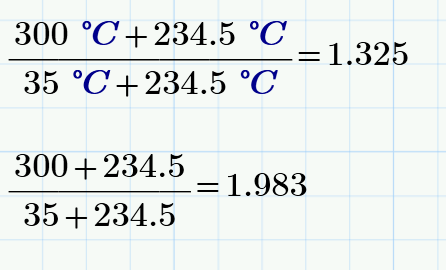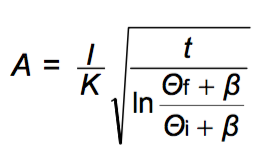Community Tip - Learn all about PTC Community Badges. Engage with PTC and see how many you can earn! X
- Subscribe to RSS Feed
- Mark Topic as New
- Mark Topic as Read
- Float this Topic for Current User
- Bookmark
- Subscribe
- Mute
- Printer Friendly Page
Samme numbers, different results???
- Mark as New
- Bookmark
- Subscribe
- Mute
- Subscribe to RSS Feed
- Permalink
- Notify Moderator
Samme numbers, different results???
Can anyone please tell explain to me why these two calculations give two different results???

Solved! Go to Solution.
Accepted Solutions
- Mark as New
- Bookmark
- Subscribe
- Mute
- Subscribe to RSS Feed
- Permalink
- Notify Moderator
Search the forum for "temperature" and you'll get a lot of info.
Mathcad's base unit for temperature is Kelvin. Since 0°K does not equal 0°C, you end up with issues that need addressed.
If you clarify the meaning behind each of the temperatures in your equation, we'd be happy to help you sort it out. If you replace all the units with Δ°C, then you get the result you're expecting. However, that might not be the best way to represent whatever you're trying to calculate.
- Mark as New
- Bookmark
- Subscribe
- Mute
- Subscribe to RSS Feed
- Permalink
- Notify Moderator
300C=(300+273.15)K etc
- Mark as New
- Bookmark
- Subscribe
- Mute
- Subscribe to RSS Feed
- Permalink
- Notify Moderator
Could you elaborate on that? Can't see what Kelvin has to do with this!?
- Mark as New
- Bookmark
- Subscribe
- Mute
- Subscribe to RSS Feed
- Permalink
- Notify Moderator
Kelvin has everything to do with it. Most units convert with just a scaling factor, but temperature units do not. There's also an additive component. If you write 300C+1C what you usually mean is increase the temperature of 300C by 1C. That is, 300C+1deltaC, where 1deltaC=1K, as opposed to 1C=274.15K. There is no other way to handle temperature units in unit aware software, because the software cannot know what you mean by 300C+1C. Add 1K, or add 274.15K? The user has to distinguish between the two possibilities, because only the user knows what they want.
- Mark as New
- Bookmark
- Subscribe
- Mute
- Subscribe to RSS Feed
- Permalink
- Notify Moderator
Welcome to the wonderful world of empirical formulas.
- Mark as New
- Bookmark
- Subscribe
- Mute
- Subscribe to RSS Feed
- Permalink
- Notify Moderator
Fred Kohlhepp написал(а):
Welcome to the wonderful world of empirical formulas.
I see in reference books more pseudoempirical than empirical formulas!
- Mark as New
- Bookmark
- Subscribe
- Mute
- Subscribe to RSS Feed
- Permalink
- Notify Moderator
Search the forum for "temperature" and you'll get a lot of info.
Mathcad's base unit for temperature is Kelvin. Since 0°K does not equal 0°C, you end up with issues that need addressed.
If you clarify the meaning behind each of the temperatures in your equation, we'd be happy to help you sort it out. If you replace all the units with Δ°C, then you get the result you're expecting. However, that might not be the best way to represent whatever you're trying to calculate.
- Mark as New
- Bookmark
- Subscribe
- Mute
- Subscribe to RSS Feed
- Permalink
- Notify Moderator
It's a part of this formula where the fraction above is the one in the ln(...). So that specific fraction should just come out as a number without any unit. How can I do that without deleting the temperature units

- Mark as New
- Bookmark
- Subscribe
- Mute
- Subscribe to RSS Feed
- Permalink
- Notify Moderator
You're right, Δ°C does work and though it's not the best solution it might be the only one ![]()
- Mark as New
- Bookmark
- Subscribe
- Mute
- Subscribe to RSS Feed
- Permalink
- Notify Moderator
Without being familiar with this equation, it's hard to give much advice.
Firstly, are you certain that the temperatures should be in °C? You'll get a different result if you use another temperature unit (°K, °F, °R).
Secondly, what do the variables Θf, Θi, and β represent?
- Mark as New
- Bookmark
- Subscribe
- Mute
- Subscribe to RSS Feed
- Permalink
- Notify Moderator
β reciprocal conductor resistance temperature coefficient at 0 °C. β in °C.
Θi onset temperature in °C. Values can be taken from IEC 60287-3-1. If there is no defined values in the national tables should ambient temperatures of 20 °C at a depth of 1 m selected.
Θf final temperature in °C
- Mark as New
- Bookmark
- Subscribe
- Mute
- Subscribe to RSS Feed
- Permalink
- Notify Moderator
As expected, this is over my head.
If you don't like using Δ°C for all the units, you could consider omitting the units for these variables. For clarification, you could put °C in a text box beside the input variable.
- Mark as New
- Bookmark
- Subscribe
- Mute
- Subscribe to RSS Feed
- Permalink
- Notify Moderator
This could also be a solution. Thank you!
- Mark as New
- Bookmark
- Subscribe
- Mute
- Subscribe to RSS Feed
- Permalink
- Notify Moderator
Someone must be doing something weird with the units to get that equation, because the reciprocal of the resistance temperature coefficient would normally have units of °C/Ohm
- Mark as New
- Bookmark
- Subscribe
- Mute
- Subscribe to RSS Feed
- Permalink
- Notify Moderator
More interesting

- Mark as New
- Bookmark
- Subscribe
- Mute
- Subscribe to RSS Feed
- Permalink
- Notify Moderator
Mathcad 15

- Mark as New
- Bookmark
- Subscribe
- Mute
- Subscribe to RSS Feed
- Permalink
- Notify Moderator
You can't add temperatures in C (or F) like that.
300C=573.15K and 234.5C=507.65K. Therefore 300C+234.5C=1080.8K=807.65C.
When you add them mentally and get the result 534.5C what you are actually doing is removing the units to get just the numeric values, adding the numeric values, and then putting the units back on. Look up temperature units in the help.
- Mark as New
- Bookmark
- Subscribe
- Mute
- Subscribe to RSS Feed
- Permalink
- Notify Moderator





